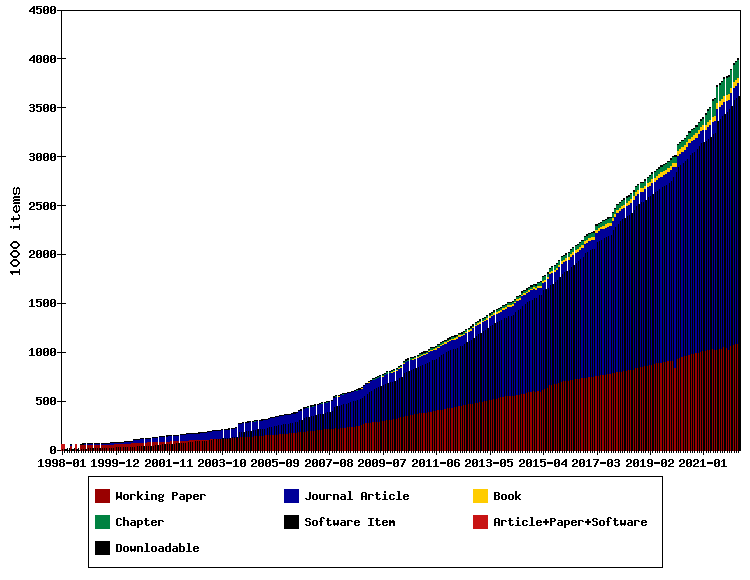25 years ago, on 12 May 1997, a meeting among a few economists and librarians laid the foundation for RePEc. Thomas Krichel describes this meeting in a recent RePEc blog post. As more research was starting to get shared on the web, it became infeasible to index all of it by hand. A new scheme was agreed on that, in essence, set rules for sharing metadata about research publications in economics. These rules still apply today, despite the tremendous growth that RePEc enjoyed. Over 2000 publishers maintain RePEc archives, carrying over 10,000 serials, including close to 4,000 journals. 25 years ago, no one was expecting that much.

Coincidentally, a few days ago RePEc surpassed 4 million indexed research items. The graph about shows the evolution of the number of research items. What is striking is that there is steady growth and that each additional million takes less time. Thus it is not that there was a big stash of research that was waiting to be tapped. Rather, the body of research evolved steadily with the popularity of RePEc. Its composition changed over time, though. The goal of RePEc was always to enhance the dissemination of research in economics, and early on the biggest need was for working papers (pre-prints) that did not enjoy the marketing or networking of commercial publishers. But soon the latter realized that they needed to participate in RePEc as well, as RePEc became the central point of dissemination in the field for big and small publishers. As all RePEc services are free for users, authors, and publishers, RePEc can thus democratize access to research.
Calling it a central point is kind of ironic, because RePEc is anything but centralized. The scheme relies on each publisher maintaining the relevant metadata on their own ftp or web site. The only central aspect of RePEc is a file directory containing pointers where those decentralized RePEc archives sit. All data is public, and other services can leverage it to disseminate economic research in any way they see fit. Now most dissemination services, not just those within the repec.org domain, use RePEc data one way or another. This makes RePEc an extremely efficient dissemination tool. It reaches a lot of users at minimal cost, as the publishers are in charge of hosting content and indexing. Even running a service using RePEc data is cheap, as the full-text content is still with the publishers. Various sponsors take care of the hosting costs or host themselves a few servers.
To make things right, there are still some non-monetary costs, though. A team of volunteers takes care of new RePEc archives, answers queries, monitors data quality, provides updates to participants, and maintains some important RePEc websites. For more details, see a short history of RePEc, instructions on how publishers participate in RePEc, and a list of RePEc archives, which are currently located in 103 countries.



 Posted by Christian Zimmermann
Posted by Christian Zimmermann
You must be logged in to post a comment.